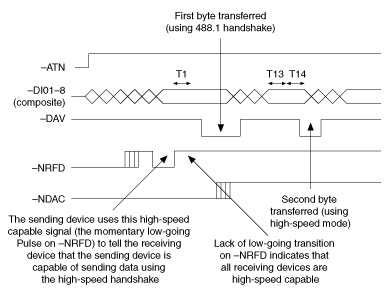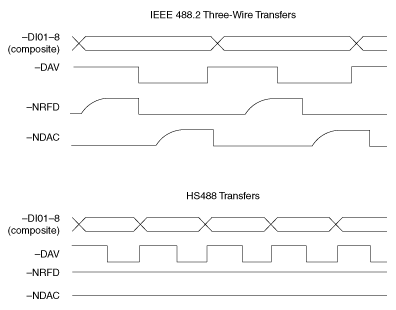HS488 Transfers
National Instruments has designed a high-speed data transfer protocol for IEEE 488 called HS488. This protocol increases performance for GPIB reads and writes up to 8 Mbytes/s, depending on your system.
HS488 is a superset of the IEEE 488 standard; thus, you can mix IEEE 488.1, IEEE 488.2, and HS488 devices in the same system. If HS488 is enabled, the TNT4882C hardware implements high-speed transfers automatically when communicating with HS488 instruments.
The following picture shows a typical IEEE 488.1 data transfer. The HS488 protocol modifies the IEEE 488.1 Source Handshake and Acceptor Handshake functions. At the beginning of each data transfer, the HS488 source and acceptor functions determine whether all active Talkers and Listeners are capable of HS488 transfers. If the addressed devices are HS488 capable, they use the HS488 noninterlocked handshake protocol for that data transfer. If any addressed device is not HS488 capable, the transfer continues using the standard three-wire handshake.

The following steps describe a typical sequence of events in an HS488 data transfer in which the Talker and Listener are both HS488 capable.

- The Controller addresses devices and becomes Standby Controller by unasserting ATN.
- The Listener asserts NDAC and NRFD.
- The Listener unasserts NRFD as it becomes ready to accept a byte.
- After allowing time for the Listener to detect NRFD unasserted, the Talker indicates that it is capable of HS488 operation by sending the HSC message. To send the HSC message true, the Talker asserts the NRFD signal.
- After allowing time for the Listener to respond to the HSC message, the Talker sends the HSC message false. To send the HSC message false, the Talker unasserts the NRFD signal.
- When the Talker has a byte ready to send, it drives the data on the DIO signal lines, allows some settling time, and asserts DAV.
- The Listener unasserts NDAC. HS488 Listeners do not assert NRFD as IEEE 488.1 devices would. Because of this behavior, the Talker determines that the addressed Listener is capable of HS488 transfers.
- The Talker unasserts DAV and begins to drive the next data byte on the GPIB.
- After allowing some settling time, the Talker asserts DAV.
- The Listener latches the byte in response to the assertion (falling) edge of DAV.
- After allowing some hold time, the Talker unasserts DAV and drives the next data byte on the DIO signal lines.
- Steps 9-11 are repeated for each data byte.
System Configuration
The HS488 Acceptor Handshake and Source Handshake interface functions depend on several time delays. Some of these delays are a function of the total system cable length.
The Controller must communicate this system configuration data to HS488 devices after the system powers on. The Controller configures HS488 devices by sourcing two multiline messages while ATN is true. The first message is the CFE message. The Controller sends the CFE message by driving a bit pattern (1E hex) that the IEEE 488.1 standard does not define on the DIO signal lines. The CFE message enables HS488 devices to interpret the SCG message that follows. The second message is a Secondary Command Group (SCG) message that contains the configuration data. The Secondary command has the bit pattern 6n hex, where n is the meters of cable in the system.